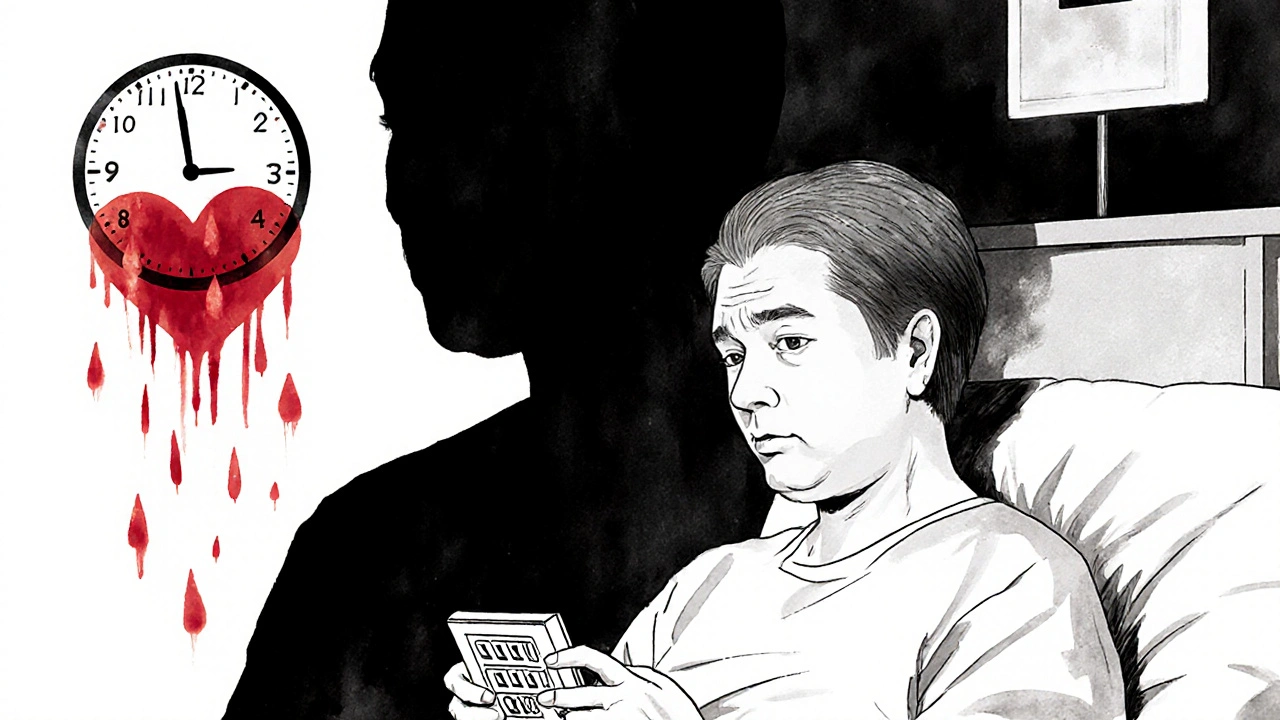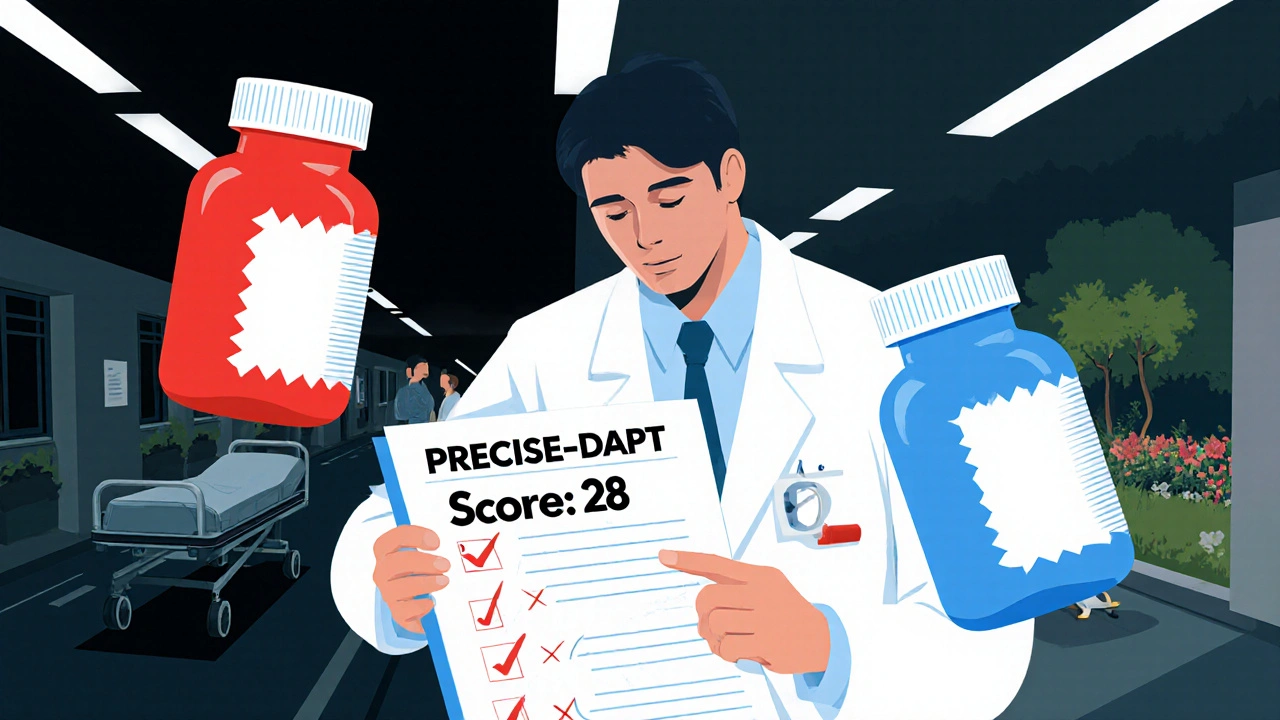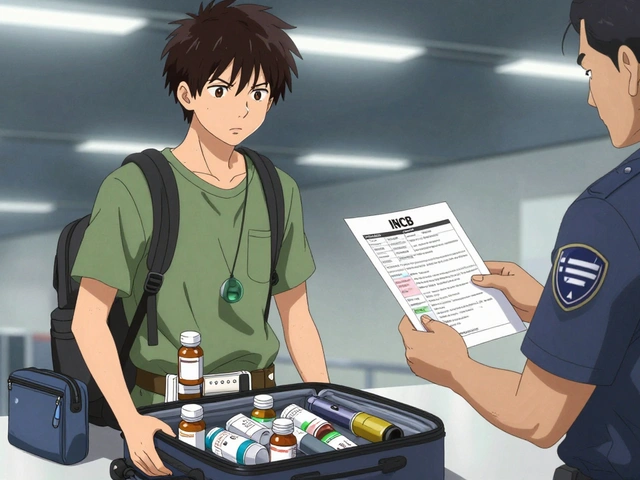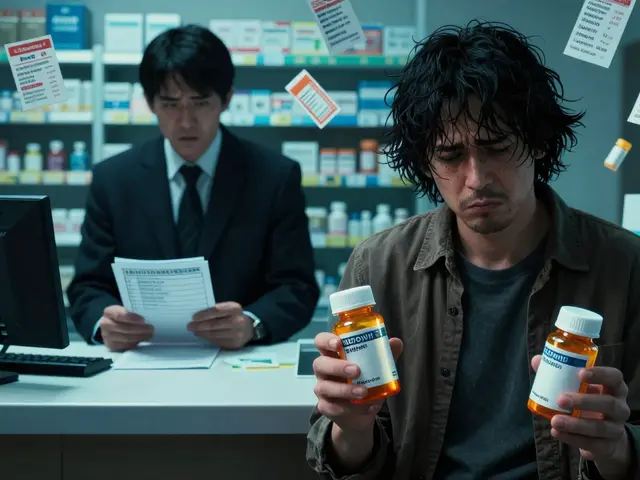
When you’ve had a heart stent placed or survived a heart attack, doctors often prescribe dual antiplatelet therapy - a one-two punch of two blood-thinning drugs to keep your arteries open. But here’s the catch: while it saves lives, it also makes you bleed more easily. That’s not just a minor inconvenience. It’s a real, daily risk that changes how you live.
Most people get aspirin plus either clopidogrel, prasugrel, or ticagrelor. Together, these drugs stop platelets from clumping together and forming dangerous clots. That’s good for your heart. But the same mechanism that prevents clots in your arteries also makes it harder for your body to stop bleeding from a cut, a nosebleed, or even a stomach ulcer. And the numbers don’t lie: for every 100 people on DAPT for a year, about 1 to 2 will have a major bleeding event - the kind that lands you in the hospital.
Why Bleeding Happens - And Who’s Most at Risk
Not everyone on DAPT bleeds the same way. Some get a tiny nosebleed every few weeks. Others bleed so much after a tooth extraction they need a transfusion. The difference? Risk factors. The most common ones are age (75+), past bleeding history, kidney problems, low hemoglobin, and taking other blood thinners like warfarin or apixaban.
Doctors use a tool called the PRECISE-DAPT score to measure your bleeding risk. If your score is 25 or higher, you’re in the high-risk group. That doesn’t mean you shouldn’t take DAPT - it means you need a smarter plan. A 78-year-old with kidney disease and a history of stomach ulcers is not the same as a 52-year-old with no bleeding history. One might need 12 months of DAPT. The other might be safer with just one month.
Studies like the MASTER DAPT trial showed that for high-risk patients, cutting DAPT from 12 months to just one month reduced major bleeding by nearly 7% - without increasing heart attacks or death. That’s a game-changer. It means we don’t have to accept bleeding as inevitable. We can adjust the treatment to fit the person.
The Drug Differences: Aspirin, Clopidogrel, Prasugrel, Ticagrelor
All DAPT combos work, but not equally. Aspirin is the constant. The real variation comes from the second drug - the P2Y12 inhibitor.
- Clopidogrel is the oldest and cheapest. It’s weaker, so it causes less bleeding - about 30-40% less than ticagrelor. But it’s also less effective at preventing heart attacks. About 1 in 5 people don’t respond well to it.
- Prasugrel is stronger than clopidogrel and works faster. But it’s risky for older or lighter patients. Doses are adjusted: 5 mg instead of 10 mg if you’re over 75 or weigh under 60 kg.
- Ticagrelor is the most potent. It cuts heart attacks and strokes better than clopidogrel. But it also causes more bleeding - 27% more, according to the TRITON-TIMI 38 trial. It also causes shortness of breath in about 15% of users, which some mistake for a heart problem.
Here’s the reality: if you’re young, healthy, and had a major heart attack, ticagrelor or prasugrel might be worth the extra bleeding risk. If you’re older, have kidney issues, or have bled before, clopidogrel is often the safer pick - even if it’s slightly less powerful.
De-Escalation: The Smart Switch
One of the biggest shifts in DAPT care over the last five years is de-escalation. That means starting with a strong drug - like ticagrelor - and switching to clopidogrel after 1 to 3 months.
The TALOS-AMI trial followed 2,583 heart attack patients. Half stayed on ticagrelor. The other half switched to clopidogrel after one month. Result? The switch group had 2.1% fewer major bleeds. No increase in heart attacks. No increase in deaths. And patients reported feeling better - less fear, more confidence in daily life.
This isn’t just theory. The FDA updated ticagrelor’s label in 2022 to include de-escalation as an approved option. Hospitals in the U.S. are now using it in nearly 40% of high-risk cases. It’s not about lowering the dose - it’s about lowering the risk without lowering protection.

What to Do When You Start Bleeding
Minor bleeding - a nosebleed that stops in 10 minutes, a small bruise, a bit of blood in your stool - is common. Don’t panic. Don’t stop your meds. But do call your doctor.
Major bleeding is different. That’s when you’re dizzy, your heart races, you’re vomiting blood, or you can’t stop bleeding from a cut after 20 minutes. If that happens, go to the ER. But here’s what they won’t always tell you: stopping DAPT too soon is dangerous.
Studies show that if you stop DAPT before six months after a stent, your risk of stent clotting jumps 2 to 3 times. That can kill you. So if you’re bleeding but stable, doctors often keep you on DAPT - even if you’re in the hospital. They’ll treat the bleed without stopping the drugs.
For severe cases, platelet transfusions can help - but only if you took clopidogrel within the last five days. There’s no antidote for ticagrelor or prasugrel yet. That’s a big gap. Unlike warfarin (which has vitamin K) or dabigatran (which has idarucizumab), we can’t just reverse these drugs. We have to wait them out.
Living With DAPT - Daily Tips
Managing DAPT isn’t just about pills. It’s about lifestyle.
- Avoid NSAIDs. Ibuprofen, naproxen, and even high-dose aspirin for headaches can increase bleeding risk. Use acetaminophen instead.
- Be careful with sharp objects. Use electric razors. Soft-bristle toothbrushes. Avoid contact sports.
- Watch your diet. Vitamin K-rich foods (kale, spinach) don’t interfere with DAPT like they do with warfarin. But alcohol? It irritates your stomach lining. Limit it.
- Tell every doctor you’re on DAPT. Even your dentist. A simple tooth extraction can turn dangerous if they don’t know you’re on antiplatelets.
- Don’t skip doses. Missing pills raises your clot risk. Set phone reminders. Use pill organizers.
And here’s something patients rarely talk about: anxiety. In one survey, 68% of people on DAPT who had even minor bleeding said they stopped doing things they loved - going out, cooking, gardening - because they feared bleeding. That’s emotional damage. But patients who switched to clopidogrel or shortened their DAPT period reported better quality of life. Their Seattle Angina Questionnaire scores went up by 15 points on average. That’s not just a number. That’s freedom.

What’s Coming Next
The future of DAPT is personalization. Right now, most people get a one-size-fits-all 6-12 month plan. But that’s changing.
The NIH is funding the DAPT-PLUS registry - tracking 15,000 patients with AI to predict who bleeds and who doesn’t. The goal? To build a model that says: “You’re low risk - you can stop after 3 months.” “You’re high risk - stay on clopidogrel.”
And researchers are working on actual antidotes. Two experimental drugs - one a fusion protein, the other an aptamer - are in early trials. If they work, we’ll finally have a way to reverse ticagrelor’s effects in an emergency. No more waiting. No more guesswork.
By 2028, experts predict 90% of stent patients will get personalized DAPT plans. That means less bleeding. Less fear. And better outcomes.
Bottom Line: It’s Not All or Nothing
Dual antiplatelet therapy isn’t a decision you make once and forget. It’s a conversation - with your doctor, with your body, with your life.
You don’t have to suffer through nosebleeds or fear every cut. You don’t have to risk a clot because you stopped your meds too early. There’s a middle ground. De-escalation. Shorter durations. Clopidogrel for those who need it. And careful monitoring.
The goal isn’t to avoid bleeding at all costs. It’s to protect your heart - without making your life smaller. And with today’s tools, that’s not just possible. It’s becoming standard.
How long should I stay on dual antiplatelet therapy after a stent?
For most people with a drug-eluting stent, 6 to 12 months is standard. But if you’re at high bleeding risk - older, past bleeding, kidney issues - your doctor may recommend just 1 to 3 months, followed by aspirin alone. Studies like MASTER DAPT show this reduces bleeding without raising heart attack risk. Never stop on your own - always talk to your cardiologist.
Can I take ibuprofen or aspirin for pain while on DAPT?
Avoid ibuprofen, naproxen, and other NSAIDs - they increase stomach bleeding risk. For headaches or pain, use acetaminophen (Tylenol) instead. Regular low-dose aspirin (81 mg) is usually part of your DAPT, but don’t take extra aspirin without checking with your doctor. Higher doses can worsen bleeding.
Is clopidogrel less effective than ticagrelor?
Yes, clopidogrel is slightly less effective at preventing heart attacks and strokes than ticagrelor - about 10-15% higher risk in some studies. But it’s also much safer for bleeding. For older patients or those with bleeding history, the trade-off favors clopidogrel. De-escalating from ticagrelor to clopidogrel after 1-3 months gives you strong protection early, then reduces bleeding risk later.
What should I do if I start bleeding heavily?
If you’re vomiting blood, passing black tarry stools, bleeding from a cut that won’t stop after 20 minutes, or feel dizzy and weak - go to the ER immediately. Don’t stop your DAPT unless a doctor tells you to. Stopping too soon can cause a deadly stent clot. At the hospital, they’ll treat the bleed while trying to keep you on DAPT if possible. Platelet transfusions may help if you took clopidogrel recently, but there’s no antidote for ticagrelor or prasugrel yet.
Can I drink alcohol while on DAPT?
Moderate alcohol - one drink a day - is usually okay. But heavy drinking irritates your stomach lining and increases bleeding risk, especially when combined with aspirin. If you’ve had a GI bleed before, avoid alcohol entirely. Always talk to your doctor about your habits. They’re not judging - they’re trying to keep you safe.
Do I need regular blood tests to monitor DAPT?
No. Routine platelet function tests aren’t recommended. Studies show they don’t improve outcomes or predict bleeding risk reliably. Doctors rely on your history, symptoms, and risk scores like PRECISE-DAPT, not lab tests. If you’re bleeding or having side effects, your doctor will adjust your meds based on your situation - not a blood result.







9 Comments
Been on DAPT for 18 months after my stent and honestly? The biggest change wasn't the meds-it was learning to stop freaking out over every little bruise. I used to avoid gardening like it was a war zone. Now I use soft brushes, skip the ibuprofen, and just breathe. That 15-point quality of life jump? Real. You don't need to live like a glass statue.
my dr switched me from ticagrelor to clopidogrel after 2 months and i couldnt believe how much better i felt. no more shortness of breath that felt like a heart attack but was just the drug. and no more bleeding gums every time i brushed. its not about being weak-it's about being smart. clopidogrel saved my chill.
So you’re telling me we’re just now realizing that one-size-fits-all medicine is garbage? Groundbreaking. The fact that this is even a conversation in 2025 says everything about how broken the system is. You’re not ‘high risk’-you’re just statistically inconvenient.
It’s deeply concerning that patients are being told to ‘just live with it’-nosebleeds, bruising, anxiety-when the pharmaceutical industry profits from prolonged DAPT. The data is manipulated. The guidelines are influenced. And yet, we’re told to trust the system. I’ve seen too many elderly patients bleed out quietly while their doctors checked boxes.
As someone from India where aspirin is sold like candy, I’m glad this is getting attention. Here, people stop meds because they think ‘it’s just blood’-but they don’t know the risk. My uncle had a stent and kept taking ibuprofen for his knees. Ended up in ICU. Please, share this with your families. Knowledge saves lives.
De-escalation protocols are now aligned with ACC/AHA Class IIa recommendations as of 2023, particularly in patients with PRECISE-DAPT ≥25. The TALOS-AMI trial demonstrated non-inferiority in net adverse clinical events (NACE) with clopidogrel switch at 30 days. This isn’t anecdotal-it’s guideline-grade evidence.
Look, I’m not some bleeding-heart liberal, but this is basic common sense. You don’t keep giving someone a loaded gun because ‘it might save them someday.’ If you’re 78 with kidney disease and a history of ulcers, you don’t need ticagrelor-you need common sense and a damn pill that doesn’t turn you into a walking hemorrhage. This isn’t politics. It’s medicine.
Y’all are so naive. 😒 The FDA approved de-escalation because they’re running out of $$$ to fund new drugs. Meanwhile, your ‘safer’ clopidogrel is 30% less effective. You think you’re saving yourself? You’re just gambling with your life. 🚨 Stop being scared of bleeding and start being scared of clotting. 💉 #DAPTisLife
Wait so if you bleed a little you’re supposed to just keep taking the meds? That’s wild. My cousin had a nosebleed that lasted 45 minutes and they still wouldn’t stop his stuff. He ended up in the ICU for 3 days. So now you’re just supposed to risk dying from bleeding to avoid dying from a clot? That’s not a middle ground. That’s a trap.